This week, guest writer Alessa Decker, examined the question of why fast-fashion brands are falling so hard, and whether Customer Experience is already more than actual interface experience. Are businesses missing the underlying needs of customers, and failing to deliver them across the broader experience landscape?
When it comes to the world of retail, customer experience normally determines the success of your brand. But doing sufficient market research BEFORE making major CX decisions will help you obtain crucial foresight, and set you in the right direction, avoiding potential long-term disaster that comes from not truly knowing your customer.
Through highly accessible methods like online panel surveys, in-store evaluations, and focus groups, you can obtain real insights and opinions from your target market, and avoid presenting a brand that simply doesn't appear to care enough.
Recently, The Financial Times reported retail sales increased 0.9 percent in January, compared with December's 0.5 percent decrease, according to the Office for National Statistics. This recent improvement was attributed to the decisive (Brexit driven) election results, making shoppers more confident about their financial outlook. In particular, "clothing stores, where sales had dropped 2 percent in December, reported a 3.9 percent rise in January." From this data, we might infer the resilient popularity of retail therapy, especially in fashion is closely linked to the positivity of a consumer's mindset.
In recent years, changing consumer needs have had a significant impact on the fashion industry. Today, Millennials and Gen Z are the primary target demographics for fast fashion, but these generations are also characterised by their awareness of societal trends, environmental degradation, and political issues. Forbes notes that customers are often choosing to invest in vintage goods or higher-quality basics in an effort to express not just their individuality, but also their beliefs. Because of these changes, both generations now have a greater demand for knowledge on how their garments are made and sourced, actively forgoing the “throwaway” culture that fast fashion promotes.
Alongside this, the issue of carbon emissions has never been higher on the agenda. More businesses have become conscious of their carbon footprints, and are changing their operations to mitigate this. Verizon Connect reports that this problem is a top priority being addressed by the government, as they hope to reduce emissions by 57% by 2030. Against this backdrop, fashion brands need to be responsible for promoting sustainability through their production methods, waste reduction and recycling, and be more transparent with consumers in the process.
A major factor in notable failures within the fast fashion industry is negative customer experience at a personal interface level. Online services, in-store returns, poor communications, etc - all lead to customers walking away. But is there also a greater underlying issue, where customers are turning away from brands that fail to answer questions regarding garment production, and sustainability?
If employees and/or supplying manufacturers of a particular company are being treated badly, it’s inevitable that the media will eventually disclose this and spread negative press. In many cases, consumers are entirely willing to boycott brands like these, instead choosing ethical brands and sustainably-sourced clothing.
That is why both qualitative and quantitative research methods to determine customer attitudes and desires are critical, before implementing business strategy. Aligning your long-term objectives with customer attitudes and trends will deliver enduring relationships with your consumers, who appreciate that you listen to and align with their motivations.
Take for example Forever 21’s case. The Retail Gazette details its gradual rise in 1984, through to its recent downfall after filing for bankruptcy protection and closing over one-third of its retail stores. Kara Buffrey from the marketing agency Clearly states that “while some retailers such as H&M and Zara have pledged to become more environmentally sustainable, Forever 21 has focused on style rather than substance.” By ignoring the ethical needs of customers and focusing on dirt-cheap discounts, the company is showing its lack of adaptation to modern-day needs. In contrast, they report that other high street brands like ASOS, New Look, Next, and River Island have followed in the footsteps of H&M by signing the Human Rights Watch’s Transparency Pledge. It’s evident that these brands care about fulfilling the needs and wants of the modern customer by providing greater transparency of their supply chain process.
The Guardian further reports that the trend of fast fashion is finally giving way to a more sustainable wardrobe. Research suggests that UK shoppers are buying clothing less frequently, with the majority of them purchasing new clothes every two or three months, instead of once a month. A wave of retailers is paying attention to this by introducing cleaning and mending services to their customers. They note how H&M has brought its free mending service to the UK, which was part of their Hammersmith store transformation. At the head of this charge is the outdoor brand Patagonia, which makes 40,000 repairs a year at its Nevada centre. In addition, LA-based Jason Markk has recently opened its sports shoe store on Carnaby Street. Since its US launch in 2014, it claims that its sneaker care professionals have cleaned more than 50,000 pairs of shoes.
Ultimately, championing sustainable fashion is a choice that many consumers have already made and continue to make on a daily basis. Paying attention to the rapidly changing needs and morals of shoppers is something that retailers must do in order to ensure their long-term survival in the highly competitive retail market.
If a business listens to the needs and wants of their customers, they are much more likely to be successful in the long run. That's why statistics from Inc. show that 89 percent of customers switch brands due to a bad customer experience, usually attributed to poor service, but now possibly much more than that.
Differentiate your brand from the crowd. Integrate and align your entire customer experience around the customer. Begin by conducting effective market research and implementing proven solutions.
Alessa Decker is a freelance business analyst with a passion for improving customer experiences and promoting sustainability. When she’s not working, Alessa enjoys rock-climbing and urban gardening.
If you'd like to talk Market Research of any kind, or the broader aspects of integrating Customer Experience, get in touch with Yomdel anytime. We love to chat.






